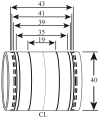Nonlinear magnetic field gradients can reduce SAR in flow-driven arterial spin labeling measurements
- PMID: 17175188
- PMCID: PMC1975926
- DOI: 10.1016/j.jmr.2006.11.011
Nonlinear magnetic field gradients can reduce SAR in flow-driven arterial spin labeling measurements
Abstract
This work describes how custom-built gradient coils, designed to generate magnetic fields with amplitudes that vary nonlinearly with position, can be used to reduce the potential for unsafe tissue heating during flow-driven arterial spin labeling processes. A model was developed to allow detailed analysis of the adiabatic excitation process used for flow-driven arterial water stimulation with elimination of tissue signal (FAWSETS) an arterial spin labeling method developed specifically for use in skeletal muscle. The model predicted that, by adjusting the amplitude of the gradient field, the specific absorption rate could be reduced by more than a factor of 6 while still achieving effective labeling. Flow phantom measurements and in vivo measurements from exercising rat hind limb confirmed the accuracy of the model's predictions. The modeling tools were also applied to the more widely used continuous arterial spin labeling (CASL) method and predicted that specially shaped gradients could allow similar reductions in SAR.
Figures





Similar articles
-
Gradient-enhanced FAWSETS perfusion measurements.J Magn Reson. 2005 Aug;175(2):185-92. doi: 10.1016/j.jmr.2005.04.002. J Magn Reson. 2005. PMID: 15886031
-
Validation and advantages of FAWSETS perfusion measurements in skeletal muscle.NMR Biomed. 2005 Jun;18(4):226-34. doi: 10.1002/nbm.950. NMR Biomed. 2005. PMID: 15674816
-
A novel continuous arterial spin labeling approach for CBF measurement in rats with reduced labeling time and optimized signal-to-noise ratio efficiency.MAGMA. 2009 Apr;22(2):135-42. doi: 10.1007/s10334-008-0157-8. Epub 2008 Dec 5. MAGMA. 2009. PMID: 19082645
-
Quantitative perfusion imaging using arterial spin labeling.Methods Mol Med. 2006;124:151-73. doi: 10.1385/1-59745-010-3:151. Methods Mol Med. 2006. PMID: 16506421 Review.
-
Tissue specific perfusion imaging using arterial spin labeling.NMR Biomed. 1994 Mar;7(1-2):75-82. doi: 10.1002/nbm.1940070112. NMR Biomed. 1994. PMID: 8068529 Review.
References
-
- Zaharchuk G, Ledden PJ, Kwong KK, Reese TG, Rosen BR, Wald LL. Multislice perfusion and perfusion territory imaging in humans with separate label and image coils. Magn Reson Med. 1999;41:1093–8. - PubMed
-
- Gach HM, Kam AW, Reid ED, Talagala SL. Quantitative analysis of adiabatic fast passage for steady laminar and turbulent flows. Magn Reson Med. 2002;47:709–19. - PubMed
-
- Norris DG. High field human imaging. J Magn Reson Imaging. 2003;18:519–29. - PubMed
-
- Fernandez-Seara MA, Wang Z, Wang J, Rao HY, Guenther M, Feinberg DA, Detre JA. Continuous arterial spin labeling perfusion measurements using single shot 3D GRASE at 3 T. Magn Reson Med. 2005;54:1241–7. - PubMed
-
- Wang Z, Wang J, Connick TJ, Wetmore GS, Detre JA. Continuous ASL (CASL) perfusion MRI with an array coil and parallel imaging at 3T. Magn Reson Med. 2005;54:732–7. - PubMed
Publication types
MeSH terms
Substances
Grants and funding
LinkOut - more resources
Full Text Sources
Medical
Miscellaneous

